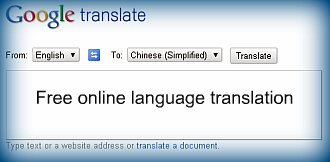Combination of Free Online Language Translation and Human Translation:
New Opportunities
Every day mullions of web-users resort to free online language translation services to translate a word, phrase, email or webpage from a foreign language. If you, like me, have ever tried these services, you know that they produce imperfect translations.
But the need to access information in foreign languages is sometimes so great that we often don’t care about less-than-perfect translation quality. There are situations in which an imperfect translation is better than zero translation. Still, free online translation output leaves much to be desired.
Have you used free language translators online? Share your experience!

Why is it so difficult for machine translation programs to translate human language? The point is that language is too nuanced and inconsistent, too filled with irregularities and exceptions to be resolved by sets of algorithms and rules that could be learned by a computer.
There are several approaches to machine translation, but the most popular are rule-based machine translation and statistical machine translation.
Rule-based systems use a set of rules (grammatical, syntactical, morphological) and bilingual dictionaries to convert a text in one language into a text in the other language. These systems have been in development since the early 1960s, but they have not improved fundamentally after years of efforts and seem to reach the limit of their possibilities.
The best known names that offer free online language translation on the basis of the rule-based approach are Systran, ProMT, and SDL.
The statistical machine translation approach entered the scene in 2004.
The essence of this approach is to feed computers with large volumes of bilingual texts (originals and respective translations made by humans). Computers then analyze these texts and learn systematic language patterns embedded in human translations.
By analyzing ever increasing volumes of the bilingual texts, statistical machine translation systems are rapidly evolving. They have already outperformed rule-based systems in translation quality.
The key feature that defines statistical machine translation systems is the ability to incorporate online community collaboration to correct raw machine translation output.
Today, Google and Microsoft Bing Translator are the most popular free online language translation portals powered by statistical machine translation approach.
To improve the quality of automatic translation, attempts have been made to create hybrid systems combining the best features of all available approaches. But web-users are still walled off from foreign language content by language barriers because free online translators still can’t produce high-quality translations from unrestricted natural language.
Free online translators can produce acceptable translations only if you feed them with a highly restricted text written in a "machine-friendly" manner, i.e. the text must have simple grammar and style and short sentences.
As we look at free online language translation services today, we see that they will not help to overcome language barriers on the web without active involvement of bilingual humans. Fortunately, there is a new trend in automatic translation towards a more intensive collaboration between volunteer translators/bilingual speakers and translation tools (automatic translation systems, translation memories, and dictionaries).
For example, machine-translated Microsoft Knowledge Base articles now undergo crowd-sourced editing by humans to improve the quality of raw machine translation output. Meedan automatically translates news and comments in the English-Arabic language pair and allows readers to improve the quality of such translations. AsiaOnline company participates in translation of Wikipedia: in-house linguists of the company post-edit raw machine translation output, which then is released and bilingual web-users help to tidy it up.
The Google Translate offers automatic translation of texts, files and web pages and invites users to contribute a better translation if they wish.
The World Wide Lexicon Translator (Firefox Translator) works in a similar way. It is oriented to translation of web pages. It enables to browse the web in over 50 languages. This tool provides automatic translations or retrieves human translations, if available, from a translation memory. The translation memory is a database made up of human edited translations submitted earlier by other users. It is possible to edit automatic translations to fix mistakes for the benefit of subsequent users. The World Wide Lexicon Translator is a free addon for the Firefox web browser.
Free online translators, such as Google Translate and World Wide Lexicon Translator, can help to reduce language barriers on the web because they enable massive collaboration with volunteer bilingual humans. Free online language translation of web pages will become better quality as more bilingual humans get involved in editing of automated translation. How soon we’ll have the truly multilingual web? Let’s wait and see.
Didn't find what you were looking for? Use this search feature to find it.
Back to Free Language Translation Page
Return from Free Online Language Translation Page to Home Page
_____________________________________________________________________ Website owner: Irina Lychak, self-employed freelance linguist, Russian translator, Ukrainian translator, Kiev (Kyiv), Ukraine